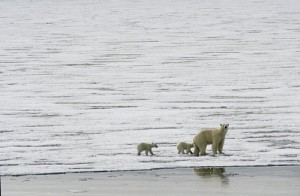Really, who does not like polar bears? Each photograph or drawing of these wild and unpredictable creatures inspires us to wonder at their snowy white fur and the adorable cubs tumbling along after them over ice and snow. When newspaper and magazine articles suggest that bears may be drowning and starving as their icy habitat melts down, we are alarmed and often confused about what’s really going on. Where’s the real information?
Most scientific studies are specific. The polar bears web page maintained by the U.S. Geological Survey (USGS), for example, collects recent scientific research about polar bears. Rather than making generalizations about how polar bears are faring, each of these studies focuses on an aspect of polar bear research and science. For example, a 2007 report from the USGS states, “Future reduction of sea ice in the Arctic could result in a loss of 2/3 of the world’s polar bear population within 50 years.” This report focused on the relationship of habitat loss to the size of the polar bear population and was generated as part of a proposal to the Secretary of the Interior to list the polar bear as a threatened species under the Endangered Species Act.
The media’s role in public understanding of the polar regions and climate change is not always based on knowledge that has been examined and evaluated by experts in a particular scientific field, but rather on what sells more newspapers and magazines. And what could possibly set off more public alarm bells than the idea of beautiful white bears drowning at sea due to melting ice?
In his article Polar Bears at Sea, New York Times writer Andrew Revkin points out that there are relatively few recent photographs of polar bears actually swimming in open water. A Google search on the term “polar bears swimming” returns several stories about polar bears swimming in open water off Alaska (without photos). A Google image search on the same term returns several photographs of polar bears swimming – they are powerfully-equipped, natural swimmers. None of these images are recent or necessarily illustrative of a polar bear drowning because there is not enough sea ice to climb on to.
While there may well be many tired polar bears swimming in northern waters, there is scant photographic evidence that documents their predicament. Reporters who want to make climate change articles appealing to the public sometimes combine their words with general photographs as illustrations.
Certain media have more of a scientific cachet than others, which means that the public is more likely to believe their content. The magazine National Geographic, for example, which implied that subscribers were being granted membership in a scientific society as “explorers” during the early years of its publication, presents facts that are often changed over time. As is the case with most magazines, different authors are engaged to research and write stories. While all the facts may be correct, one story may not jibe with what another story says in a different context or circumstance. The benefit for readers is that they may see an issue reported from one point of view and then from a different point of view as a story evolves. And stories about science always change over time as discoveries are made.
MULTIPLE SOURCES OF INFORMATION
The best way to figure out what’s really happening to polar bears as polar ice melts (or any other climate change issue related to the poles) is to read several accounts of the event from different sources. Here are some tips to keep in mind when combing through the news:
Who is the publisher?
What type of organization is publishing the information?
- not-for-profit
- scientific
- government agency
- for-profit news organization or company
- consumer magazine or company
- scientific consumer magazine or company
What are the key differences in the story from the point of view of at least two different types of publishers?
What would you emphasize in a news story about polar bears?
This article was written by Carol Minton Morris. For more information, see the Contributors page. Email Kimberly Lightle, Principal Investigator, with any questions about the content of this site.
Copyright October 2008 – The Ohio State University. This material is based upon work supported by the National Science Foundation under Grant No. 0733024. Any opinions, findings, and conclusions or recommendations expressed in this material are those of the author(s) and do not necessarily reflect the views of the National Science Foundation. This work is licensed under an Attribution-ShareAlike 3.0 Unported Creative Commons license.


